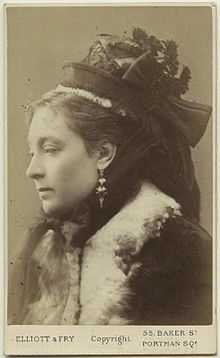Lydia Foote
| Lydia Foote | |
|---|---|
 portrait from 1873 | |
| Born | 1843 |
| Died |
30 May 1892 Broadstairs |
| Nationality | England, United Kingdom |
Lydia Foote or Lydia Alice Legg (1843 – 30 May 1892) was an English actress. She played leading roles from the 1850s to the 1880s, including at the Lyceum Theatre, the Olympic Theatre, the Prince of Wales's Theatre and the Adelphi Theatre. She was known for her performances in such plays as The Frozen Deep (1866) and Caste (1867).
Life
Foote was born in 1844 in London with the name of Lydia Alice Legg. Her father, Arthur Wellington Legg, was a coachbuilder whist her mother, Sarah Judith Legg had been born with the surname of Goward. Her maternal aunt was Mary Anne Keeley, a noted actress.[1][2] Coming from an acting family Foote enjoyed a degree of respect that was generally not available to many female actors as their profession was seen as indicative of sexual availability.[3]
Foote played leading roles from the 1850s to the 1880s. She debuted in London at the Lyceum Theatre in 1852 in the juvenile role of Edward in A Chain of Events by Charles Mathews and Slingsby Lawrence.[4] About 1859, she played Amanthis in The Child of Nature by Elizabeth Inchbald.[2] In 1863–1866, after other performances in London, Manchester and elsewhere, she was engaged at the Olympic Theatre, where she first appeared in the Ticket of Leave Man as May Edwards. In that piece, Foote delivered a song that was issued as the song that Lydia Foote sang.[5] In 1864 there, she created the role of Enid in Tom Taylor's adaptation of The Hidden Hand, and in the following year created another role, Miss Hargrave, in Taylor's Settling Day. She also played Maria in Twelfth Night.[2] In 1866, she received warm reviews as Clara in Wilkie Collins's The Frozen Deep".[4]
The Dictionary of National Biography refers to her "great triumph" as her performances as Esther in T. W. Robertson's Caste, at the Prince of Wales's Theatre in 1867.[6][7] She continued to perform regularly in West End theatres,[4] including in the roles of Lady Selina in How She Loves Him by Dion Boucicault and as Amanda in Robertson's Play (1868). In H. J. Byron's Blow for Blow, she played twin sisters, and she had the title role in his play Minnie. She also took the leading role in Robertson's Progress. She later performed many roles at the Adelphi Theatre, including Smike in a stage version of Nicholas Nickleby (1875). She originated the roles of Anna in The Danischeffs by Lord Newry (1877) and Midge in Boucicault's Rescued (1879), among others.[2]
Foote died in Broadstairs from cancer in 1892 and was buried at Kensal Green cemetery.[1][2]
References
- ↑ 1.0 1.1 Joseph Knight, ‘Foote, Lydia (1843–1892)’, rev. J. Gilliland, Dictionary of National Biography, Oxford University Press, first published 2004; online edn, Oct 2007, with portrait illustration
- ↑ 2.0 2.1 2.2 2.3 2.4 "Lydia Foote", The Library of Nineteenth-Century Photography, accessed 9 November 2014
- ↑ Goodman (ed), Lizbeth (2002). The Routledge Reader in Gender and Performance. p. 73. ISBN 1134707606. Retrieved 25 October 2014.
- ↑ 4.0 4.1 4.2 Pascoe, Charles Eyre (ed.). "Foote, Lydia A." Our actors and actresses. The dramatic list, London: David Bogue, p. 149 (1880)
- ↑ Guy Little Theatrical photo, Victoria and Albert museum, retrieved 25 October 2014
- ↑ Full text of Society and Caste edited by T. Edgar Pemberton (1905) via www.archive.org. Accessed Feb 2014.
- ↑ The Times, 11 April 1867
External links
| Wikimedia Commons has media related to Lydia Foote. |
- Lydia Foote at the National Portrait Gallery